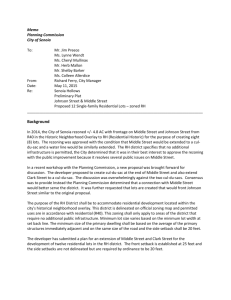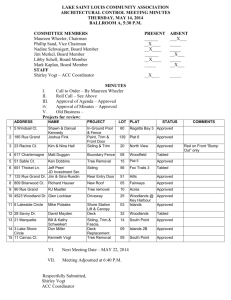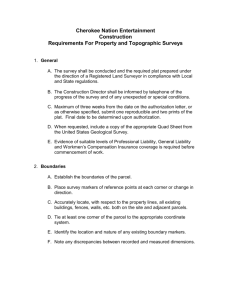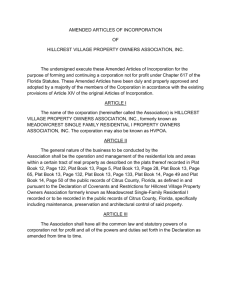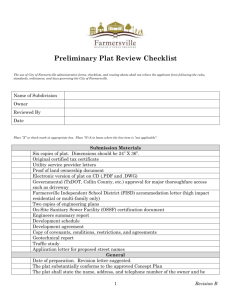Standards of Practice For Maps and Plats
advertisement
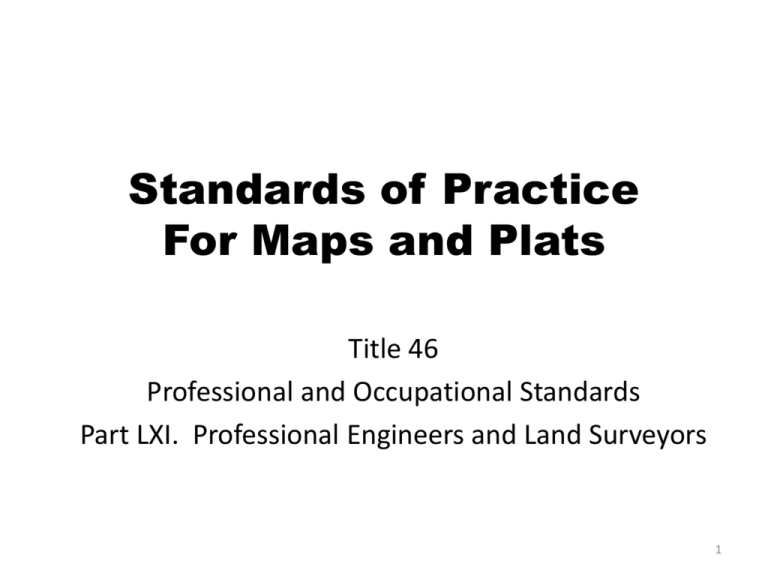
Standards of Practice For Maps and Plats Title 46 Professional and Occupational Standards Part LXI. Professional Engineers and Land Surveyors 1 TYPES OF BOUNDARY SURVEY • Three types of boundary surveys, which relate to or define property boundaries, are regulated by the Standards of Practice. • Boundary Survey Types 1. Property Boundary Surveys 2. Route Surveys (Right-of-ways, Easements) 3. Mineral Unitization Surveys 2 CLASSIFICATION OF SURVEYS – Defines the Degree of Accuracy for the survey • Positional Accuracy - the difference between the actual position of a monument and the position as reported on the plat. • Positional Tolerance- the distance that any monument may be miss-located in relation to any other monument cited in the survey 3 CLASSIFICATION OF SURVEYS – Based upon purpose for which property is being used at time of survey and proposed development of property disclosed by the client • Proposed development should be discussed with client • Survey classification will determine the amount of investigation and field work (and the cost) of the survey 4 CLASSIFICATION OF SURVEYS – Survey Classes • Class A – Maximum Survey Accuracy Urban Business Districts Highly Developed Commercial Properties • Class B – High Degree of Survey Accuracy Commercial Property outside of Urban Business Districts Higher Priced Residential Properties • Class C Suburban Area Properties Residential areas not classified as Class A or B surveys • Class D Rural Area Properties Farm Lands All other surveys not classified as Class A, B, or C surveys 5 POSITIONAL ACCURACY SPECIFICATION AND POSITIONAL TOLERANCES • If radial survey methods, global positioning systems (GPS) or other acceptable technologies or procedures are used to locate or establish points on the boundary survey, the professional land surveyor shall apply acceptable surveying procedures in order to assure that the allowable positional accuracy and/or positional tolerance of such points are not exceeded. • Any conversion from meters to feet shall use U.S. Survey Feet. 6 POSITIONAL ACCURACY SPECIFICATION AND POSITIONAL TOLERANCES Condition A Urban Business District 1:15,000 Angular Closure (maximum allowable) Accuracy of Bearing Unadjusted Closure (maximum allowable) Linear Distances Accurate to: (maximum allowable) Positional Tolerance and Positional Accuracy of any Monument (maximum) B C D Urban Suburban Rural 1:10,000 1:7,500 1:5,000 10''√N 15''√N 25''√N 30''√N ± 15 Sec. ± 20 Sec. ± 30 Sec. ± 40 Sec. 0.05 ft ± ± 0.05 ft per 1,000 ft 0.05 ft ± ± 0.1 ft per 1,000 ft 0.07 ft + ± 0.15 ft per 1,000 ft 0.1 ft + ± 0.2 ft per 1,000 ft 0.1' + AC/15,000 0.1' + AC/10,000 0.1' + AC/7,500 0.2' + AC/5,000 Remarks and Formula Traverse Loop or between Control Monuments (closed traverse) N = Number of Angles in Traverse (closed traverse) In Relation to Source (closed traverse, radial or GPS) Applies when the Distance is not part of a Closed Traverse (radial or GPS) AC = Length of Any Course* (closed traverse, radial or GPS) To 1 acre To 10 acres To 100 acres To 1,000 acres Calculation of area - accurate 0.001 0.001 0.001 0.001 and carried to nearest ____ 0.001 0.001 0.01 0.01 (decimal place) of an acre 0.01 0.01 0.1 0.1 (closed traverse, radial or 0.1 0.1 0.2 0.3 GPS) Elevations for Boundaries 0.2 ft. 0.3 ft. 0.4 ft. 0.5 ft. Based on Accepted Controlled by Tides, Local Datum (closed Contours, Rivers, etc. traverse, radial or Accurate to: GPS) Location of Improvements, ± 0.1 ft. ± 0.2 ft. ± 0.5 ft. ± 1 ft. (closed traverse, Structures, Paving, etc. radial or GPS) (Tie Measurements) Adjusted Mathematical 1:50,000 1:50,000 1:50,000 1:50,000 (closed traverse, Closure to Survey radial or GPS) (Minimum) *Short courses in categories "A" and "B" may generate positional errors of less than 0.01 feet. A minimum course distance of 200 feet shall be used in calculating positional error. 7 PROPERTY BOUNDARY SURVEY DEFINITION • A survey which, after careful study, investigation, and evaluation of major factors influencing the location of boundaries, results in the deliberate location or relocation on the ground of, one or more boundaries... • and results in the recovery or installation of monuments that define the location and extent of, one or more boundaries. 8 PROPERTY BOUNDARY SURVEY DEFINITION • Surveying and mapping functions which meet the definition of a property boundary survey are: a. boundary surveys b. subdivision surveys and plats; c. public land surveys. 9 PROPERTY BOUNDARY SURVEY DEFINITION And whenever establishment of the relationship of property ownership boundaries are required: d. surveys of servitudes and rights of way e. surveys of leases f. topographical surveys g. surveys for record h. layout surveys for construction i. hydrographic surveys j. mine surveys k. mapping 10 PROPERTY BOUNDARY SURVEY DEFINITION • Any plat or map prepared from surveying and mapping activities which does not meet the definition of a property boundary survey, shall have a note stating that it that does not represent a property boundary survey. 11 PROPERTY BOUNDARY SURVEY PURPOSE • The primary purpose of the property boundary survey is to locate or relocate the physical position and extent of the boundaries of real property, and the discovery of visible evidence of prescriptive rights relating thereto. 12 PROPERTY BOUNDARY SURVEY PURPOSE • A property boundary survey may also include the location or relocation of the physical position and extent of political boundaries which define the perimeters of public or private ownership. 13 PROPERTY BOUNDARY SURVEY PURPOSE • In addition, the property boundary survey is a means of marking boundaries for sufficient definition and identification to uniquely locate each lot, parcel, or tract in relation to other well recognized and established points of reference, adjoining properties and rights-ofway. 14 PRODUCT • A property boundary survey will result in the establishment of monumented corners; points of curvature and tangency; and reference points. Reference monuments shall be established or reestablished when required (witness monuments). 15 PRODUCT • In event that no plat of survey is required, the professional land surveyor must maintain adequate records to substantiate his/her professional opinion in reestablishing boundary lines and corners on a survey. 16 PRODUCT • If requested by the client, a boundary survey may also include the following: – A signed and sealed metes and bounds written description depicting the surveyed boundary. – A certified map or plat depicting the survey as made on the ground. – A signed and sealed written report of the surveyor's findings and determinations. 17 RESEARCH AND INVESTIGATION • Where the purpose of a property boundary survey neither requires nor includes research and investigation of servitudes, a note to that effect shall be placed upon the plat or map of survey. However, when such research or investigation is required, the professional land surveyor shall request from the client or their agent the most recent legal description, plats or maps describing the property to be surveyed. 18 RESEARCH AND INVESTIGATION • The professional land surveyor shall then evaluate the necessity to obtain the following data based on the specific purpose of the survey: 19 RESEARCH AND INVESTIGATION – additional recorded legal descriptions and plats or maps of the tract to be surveyed and tracts adjoining or in proximity to the property to be surveyed; 20 RESEARCH AND INVESTIGATION – the recorded legal descriptions of adjoining, severing, or otherwise encumbering servitudes or rights-of-way, including but not limited to, highways, roadways, pipelines, utility corridors, and waterways used for drainage, navigation or flood control; and 21 RESEARCH AND INVESTIGATION – grants, patents, subdivision plats or maps or other recorded data that will reference or influence the position of boundary lines. 22 PLATS AND MAPS • Many changes were made to this section of the Standards of Practice • Every original plat or map of a boundary survey should be a reproducible drawing at a suitable scale which clearly shows the results of the field work, computations, research and record information as compiled and checked. 23 PLAT AND MAP GUIDELINES 1. Any reasonably stable and durable drawing paper linen or film of reproducible quality will be considered suitable material for boundary survey plats and maps. 24 PLAT AND MAP GUIDELINES 2. The minimum dimensions for plats and maps shall be 8 inches by 10 1/2 inches. 25 PLAT AND MAP GUIDELINES 3. All dimensions, bearings or angles, including sufficient data to define the curve shall be neatly and legibly shown with respect to each property or boundary line. To define a circular curve, the following four elements shall be shown: chord bearing, chord distance, arc (length), and radius. All lines and curves shall show sufficient data on the plat to calculate a plat or map closure. 26 PLAT AND MAP GUIDELINES 4. Monuments shall be labeled as "found" or "set" with a sufficient description of the monument. The description shall include but not be limited to the size and type of material, and relevant reference marker, if any, along with their position in relation to the corner. 27 PLAT AND MAP GUIDELINES 5. When the purpose of the property boundary survey dictates, the area of the tract and all pertinent natural or man-made features located during the course of the field survey (water courses, streets, visible utilities, etc.) shall be labeled or represented by an appropriate symbol on the plat or map in its proper location. When appropriate, the feature shall be dimensioned and referenced to the nearest property line. 28 PLAT AND MAP GUIDELINES 6. A statement indicating the origin of azimuths or bearings shall be shown on each plat or map. If bearings are used, the basis of the bearing shall include one or more of the following: 29 PLAT AND MAP GUIDELINES a. reference to true north as computed by astronomic observation within one mile of the surveyed site; b. reference to the Louisiana State Plane Coordinate System with the appropriate zone and when applicable a controlling station(s) with coordinates and datum used; c. reference to the record bearing of a well-established line found monumented on the ground as called for in a relevant deed or survey plat or map; d. when none of the above alternatives are practical, a magnetic bearing (corrected for declination) may be used. 30 PLAT AND MAP GUIDELINES 7. If a coordinate system other than the Louisiana State Coordinate System is used on a map, that system shall be identified. If that system is the Louisiana State Coordinate System, the appropriate zone shall be shown on the map. 31 PLAT AND MAP GUIDELINES 8. Where the new survey results differ significantly from the prior deed information in regard to course, distance, location or quantity, the plat or map shall indicate such differences or discrepancies. 32 PLAT AND MAP GUIDELINES 9. Where separate intricate details, blowups or inserts are required for clarity, they shall be properly referenced to the portion of the plat or map where they apply. This applies particularly to areas where lines of occupation do not conform to deed lines and to areas where a comparison of adjoining deeds indicates the existence of a gap or an overlap. 33 PLAT AND MAP GUIDELINES 10.Cemeteries and burial grounds known by the professional land surveyor to be located within the premises being surveyed shall be indicated on the plat or map. However, a detailed survey of the limits of the cemetery shall not be required unless directed by the client. 34 PLAT AND MAP GUIDELINES 11.When the purpose of the property boundary survey dictates, properties, water courses and rights-of-way surrounding, adjoining, or severing the surveyed site shall be identified. Private lands or servitudes should be labeled with the name of the owner or with a reference to the deed under which ownership is held, provided that such information is furnished by the client. 35 PLAT AND MAP GUIDELINES 12.Original section, grant, subdivision or survey lines, when an integral part of the deed, shall be shown in proper location with pertinent labeling. A measurement of course and distance shall be shown to a parent tract corner, block corner, section corner, subdivision or grant corner, and existing monuments shall be indicated. 36 PLAT AND MAP GUIDELINES 13.Differing line weights or delineating letters or numbers (A, B, C, etc. or 1, 2, 3, etc.) shall be used to clearly show the limits of what is being surveyed. 37 PLAT AND MAP GUIDELINES 14.Each plat, map or drawing shall show the following: a. caption or title; b. client and/or purpose; c. vicinity map. A vicinity map will not be required if there are sufficient features and landmarks (officially named streets and street intersections, lots and blocks within a subdivision, adjoining subdivisions, Township-Range-Section lines, etc.) on the plat or map that would sufficiently enable a person to identify the location of the survey site; d. the date of the survey; 38 PLAT AND MAP GUIDELINES a. name, telephone number, mailing address and license number of the professional land surveyor, or the firm who employs the professional land surveyor; b. signature and seal of the professional land surveyor under whose direction the survey was done: c. scale, written and/or graphic; d. north arrow, and it is recommended that the drawings be oriented so that north is toward the top of the sheet; and e. legend for symbols and abbreviations used on the plat or map. 39 PLAT AND MAP GUIDELINES 15.Final plats or maps issued to the client shall contain a certification statement by the professional land surveyor certifying its authenticity (that it represents his/her survey) and stating that the property survey is in accordance with the applicable standards of practice as stipulated in this publication, based on the current survey “classification” 40

